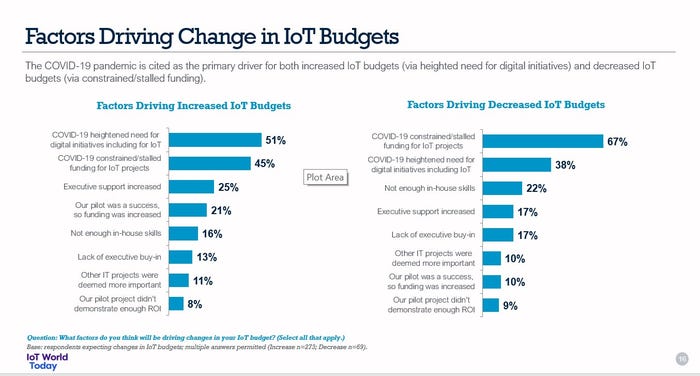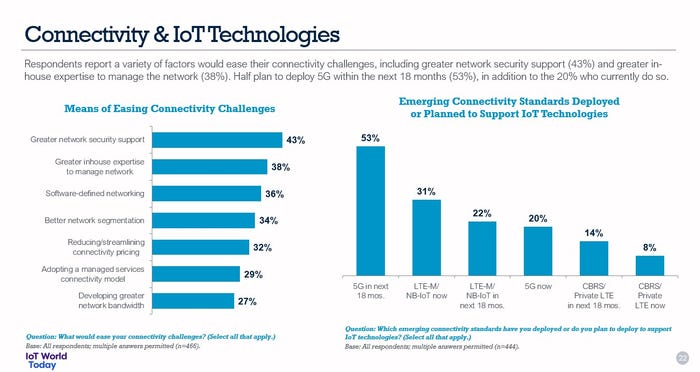Network Connectivity Paves Way, with Caveats, for IoT Adoption
Respondents to an IoT adoption survey said that network connectivity options, including 5G, will enable projects. But there are hurdles in the quest for better network performance.
October 7, 2020

Key takeaways from this article are the following:
Despite a turbulent 2020, more than 40% of respondents said that their IT budgets will increase by the end of 2020 and 51% expect them to increase by Q1 2021.
Respondents to the recent 2020 IoT Adoption Survey said that they will implement 5G-related technologies within 18 months.
While respondents are enthused about the prospects for 5G to provide lower latency and high performance, 41% said that connectivity challenges are hurdles to IoT deployments.
This year, Internet of Things (IoT) projects continued apace, despite the COVID-19 pandemic. Two-fifths of respondents (41%) expect their IoT budgets to increase by the end of 2020; 51% expect them to expand in Q1 2021.
Further, 51% of respondents to the 2020 IoT Adoption Survey said that COVID-19 has spurred digital transformation projects, including IoT.

Edge Architecture Increasingly an Enabler for IoT Devices
As practitioners delve into Internet of Things deployments, they have relied on network connectivity to enable efficiency. Indeed, when asked which technologies underpin an IoT deployment, 86% said that connectivity is the most essential element.
Further, for respondents, more than one-third use edge computing architecture — which brings compute, storage and networking resources closer to to the devices and users that need them, reducing latency latency in addition to cloud architecture (65%) and centralized data centers (53%).
Bringing resources closer to devices and users, for example, offers promise for enterprises to create new experiences by having access to high-volume data with less latency and improved performance.
“The IT pendulum is swinging back toward distributed — applications are in the cloud, on-prem, at the edge — as a result, the environment is getting way more complex,” said Bob Laliberte, practice director and senior analyst at ESG, a research firm.
Instead of sending data back to a centralized cloud or data center, those in the field can analyze information and make decisions in real time—such as whether to shut down malfunctioning equipment or the ability to deny access to an unidentified device trying to gain access to a network that may pose a threat.
Today, less than 10% of enterprise-generated data is created and processed at the edge, according to Gartner; but by 2025, that will grow to 75%, Gartner predicts..
Many respondents show significant interest in deploying 5G technologies.; 53% of survey respondents said that they plan to deploy 5G-related technologies.
Challenges for IoT Network Connectivity
At the same time, hurdles persist with connectivity relating to technology and skills.
For many IoT Adoption Survey’s respondents, connectivity (41%) is a top challenge in deploying IoT, alongside data security (46%), and lack of in-house skills to manage networks (34%).

According to experts, the edge architecture and network automation of have become a prime focus.
“We’ve seen a lot of transformation taking place in the IT infrastructure, to create a modern network environment,” said ESG’s Laliberte. “There’s a lot more focus on automation. To overcome [IT] complexity, organizations need to leverage automation, AI/ML in order to make sense of all that data in a real-time fashion and get actionable insights.”
Methodology
Between June and August of 2020, IoT World Today surveyed 471 respondents about their IoT adoption plans and budget. Fifty-nine percent of respondents were from the U.S., 14% from Europe, 10% from Asia and 17% from other regions. Fifty-eight percent were from companies of fewer than 500 employees, 17% were from companies of 10,000-plus employees, 29% are from companies of 1,000–9,999 employees, and 7% are from companies of 500-999 employees.
About the Author
You May Also Like






